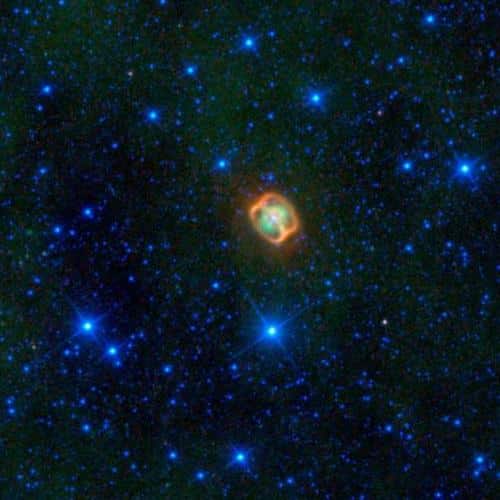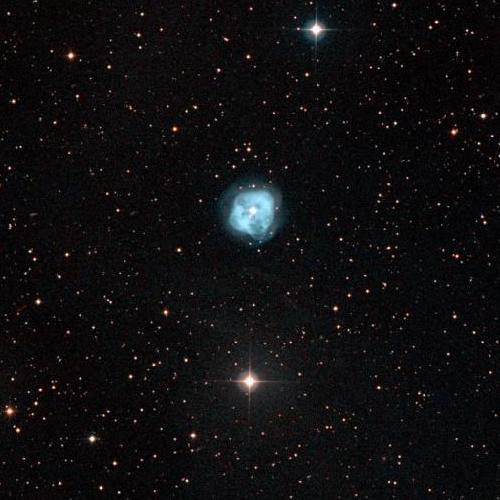A new image from NASA's WISE space telescope shows what appears to be a glowing jellyfish floating at the bottom of a sea full of small specks. In fact, this creature belongs to the universe - it is a dying star surrounded by glowing gas and two unusual rings

In the images are two views of the strange dead star, also known as the planetary nebula NGC 1514. The image on the left is from a ground-based visible light telescope. The image on the right was photographed in infrared light by NASA's WISE space telescope.
A new image from NASA's WISE (Wide-field Infrared Survey Explorer) space telescope shows what appears to be a glowing jellyfish floating at the bottom of a sea full of small spots. In fact, this creature belongs to the universe - it is a dying star surrounded by glowing gas and two unusual rings.
“I remembered the jellyfish exhibit at the Monterey Bay Aquarium. Beautiful things float in water, but this thing is in space," said Edward Wright, principal investigator of the Wise mission at UCLA, and co-author of the study published in the Astrophysical Journal.
The object known as NGC 1514 and sometimes also the Crystal Ball Nebula belongs to a class of objects called planetary nebulae, where a dying star sheds its outer layers of material. Ultraviolet light from the central star, or in this case from a pair of stars, causes the gas to glow due to colors. The result is often beautiful - these objects are considered the butterflies of space.
NGC 1514 was discovered in 1790 by Sir William Herschel, who testified that the "luminous liquid" meant it could not be a pale cluster of stars, as initially suspected. Herschel coined the term planetary nebula to describe similar objects with formations surrounding it like planets.
Planetary nebulae with asymmetric wings are common, but nothing like the recently discovered rings around NGC 1514 has ever been seen. Astronomers say the rings are made of dust thrown up by two dying stars located in the center of the nebula. This eruption of the dust crashing back into the stars is visible thanks to the leveling of the dust already done earlier by the stars' winds, creating the rings.

"I'm looking at one of my favorite objects in the Wiese catalog right now and I was surprised to see the rings," says Michael Ressler, a Wiese science team member at NASA's JPL in Pasadena, California and principal investigator of the Astrophysical Journal article. Ressler actually fell in love years ago when he was playing with his amateur telescope on a camping trip in the desert. "It's funny that it comes around again to come full circle."
Wise was able to observe the rings for the first time because they heat up and glow in the infrared light he can see. In visible light images, the rings are hidden from view in the shadow of the glowing gas cloud. "This bone has been studied for over 200 years, but Wise showed us that there are always surprises." Ressler said.
According to Ressler, the structure of NGC 1514 is not unique, and is almost certainly similar in overall geometry to other hourglass-like nebulae, such as the Engraved Clock Nebula http://hubblesite.org/newscenter/archive/releases/1996/07. The structure looks different in WISE because the rings can only be detected due to their heat, they do not glow in the wavelengths of visible light, as is also the case with the other objects.
Serendipitous discoveries have already become common in survey missions such as WISE, which scan the entire sky. Wiz began scanning the sky in infrared light since January 2010, and so far has cataloged hundreds of millions of asteroids, stars and galaxies. At the end of September, after covering the sky one and a half times, he ran out of the coolant needed to cool the detectors. The mission, now called NEOWISE, is still scanning the sky with two of the detectors and focuses mainly on comets and asteroids, including near-Earth objects.
The members of the Wiese scientific team estimate that there are many more surprises of the type of NGC 1514 in the sea of data collected by the spacecraft - and the first cluster of which will be released to the astronomical community in the spring of 2011.
http://www.nasa.gov/mission_pages/WISE/news/wise20101117.html

7 תגובות
Hi Abby no pressure… I just wanted to introduce this guy to the guys. This is truly a fine blog for science lovers.
I just "caught a ride"... and you are right that it will be interesting even in a year.
But what a beautiful nebula
The distance of NGC1514 is about 600 light years from the Earth
http://en.wikipedia.org/wiki/NGC_1514
Sparrow, every blog is hard to follow. When you see it on the NASA website, then I start working, and unfortunately I don't have the resources to translate any information from there. Indeed, this news was delayed for several days because there was more urgent space news, but this is news of a type that will always be of interest regardless of the exact day of its discovery.
By the way, the story appeared about two weeks ago on the blog of a lovable astronomer named Phil Plait
Mouth:http://blogs.discovermagazine.com/badastronomy/2010/11/17/warm-dusty-rings-glow-around-a-weird-binary-star/
How far is the star from here?
Amazing photos, thank you very much, my father
Sometimes I say to myself, we humans blow things up and only bad things come out of it, and the big bang created for us an amazingly beautiful universe from a small explosion.